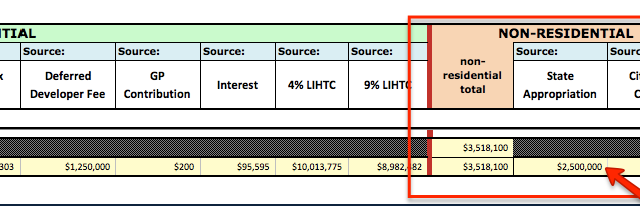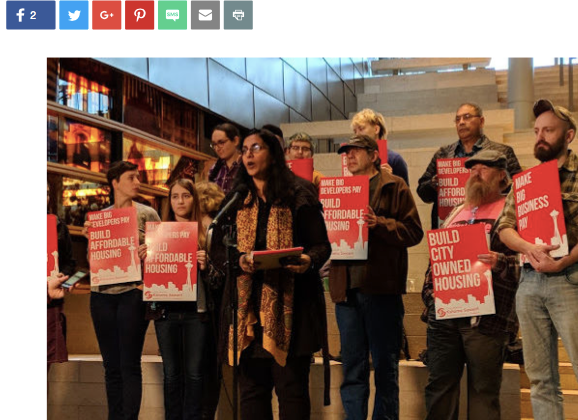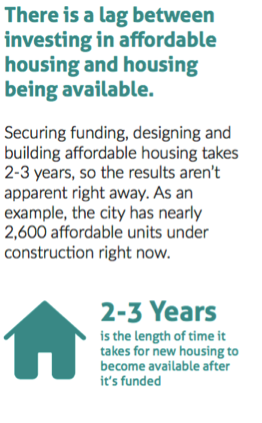Memories: Looking Back to Our Appeal of the Low-Rise Rollback
Can it be that it was all so simple then
Or has time rewritten every line
If we had the chance to do it all again
Tell me, would we?
Could we?
Sigh.
More than 4 years ago, in the summer of 2014, we put together an appeal of the Determination of Non-Signficance (DNS) on a raft of proposed changes to Seattle’s low-rise zones. That proposal was an effort to undo the density that was intended by previous legislation. Then, as developers and builders did just what the legislation intended, building more apartments rather than townhomes, the angry neighbors showed up demanding blood. Councilmember Sally Clark and her colleagues complied, proposing legislation that forced inclusion of lots of dead space in allow Floor Area Ratio (FAR). The result was fewer, larger, and more expensive apartments at a time when what was needed was more, smaller, less expensive units.
Well, here we are 4 years later and things have gotten worse at City Hall. People at City Hall trot out the “housing crisis” phrase on an almost daily basis. It’s like listening to a pull string doll that pulls it’s own string: “Housing crisis! Housing crisis! Housing crisis!” Yet, what the City does is the exact opposite of what is called for in an economy with housing scarcity: allow and incentivize more and more housing. If only when they pulled they actually did something to support that policy or even better just left well enough alone. But that’s asking for too much. Just recently the City dropped another DNS, a document that claims that the bureaucrats reviewed a proposal and determined that, if implemented, it would have no impact on the environment. This one is on impact fees.
Now I’ve said before, impact fees are legal and well litigated and in many ways better than the inflationary and illegal Mandatory Inclusionary Zoning (MIZ) shake down the City calls Mandatory Housing Affordability (MHA). The latest DNS is for a change in the Comprehensive Plan that would create an opening in the plan for imposition of fees. That legislation would require another process to determine where the money would go and how the fees would be assessed. So an appeal of the DNS on impact fees wouldn’t be on the specifics or legality of impact fees but rather on whether the City has done what it should to assess the impact.
Angry neighbors have turned the appeal into a sacrament at this point, raising money and hiring attorneys to waylay and harass proposals for modest changes to back yard cottage requirements or stalling MHA because they don’t want more people moving into their neighborhoods. Ironically, the neighborhoods are helping out thousands of people with the MHA appeal, keeping it off the books and allowing projects to get vested before it can be implemented citywide. This means hundreds of units will avoid having to absorb the cost of fees; people who need housing won’t have to subsidize MHA with higher rents.
What would an appeal of the latest impact fee gambit look like and what would it do? It would likely be based on the fact that impact fees won’t be paid by developers but by people who need housing; rents and housing costs will go up. Second, like any DNS appeal, the argument would be that the City didn’t do enough to figure out what impact fees would do to the local housing economy and how that would affect the environment. In the end, even with a favorable decision, the appeal would not necessarily stop the eventual imposition of impact fees.
An appeal of the impact fee DNS would help make the case that the proposal really did not do what it should, make the City reconsider, and, ultimately, maybe, they’d drop the idea. More fees won’t lower housing prices, period. Perhaps that notion would catch on at City Hall.
As someone we all know likes to say, “We’ll see what happens.”
For old time’s sake I thought I’d share the heart of our low-rise appeal. You’d think by now we’d be beyond all this process and be building an abundance of housing, of all kinds in every neighborhood for people of all levels of income.
DECISION BEING APPEALED
Smart Growth Seattle appeals the City’s SEPA DNS issued for Land Use Code Text Amendments for Lowrise Multi-Family Zoning Code Adjustments (the “Lowrise Multifamily Zoning Code Adjustments”). A copy of the DNS is enclosed.
APPEAL INFORMATION
1. What is your interest in this decision? (State how you are affected by it)
Roger Valdez is the Director of Smart Growth Seattle, and a resident of the City of Seattle. Smart Growth Seattle is a non-profit membership organization that advocates for policies to increase housing supply and meet demand for housing created by new jobs. While named “Smart Growth Seattle,” the group recognizes that the impacts of land use decisions taken by the City of Seattle extend beyond the City’s incorporated boundaries. Therefore, Smart Growth Seattle advocates for the implementation of sound growth strategies under the State’s Growth Management Act (“GMA”), including creating more housing choices and supply in Seattle that support more growth inside the City, rather than outside the Urban Growth Boundary. Smart Growth Seattle asserts that the current proposal to adopt the Lowrise Multifamily Zoning Code Adjustments and the environmental impacts of the proposal are antithetical to principles of smart growth, the GMA, and the City’s own Comprehensive Plan.
Smart Growth Seattle and Roger Valdez have participated in public meetings and provided comment on the proposed Lowrise Multifamily Zoning Code Adjustments, including written correspondence to the City. Smart Growth Seattle’s members (and the entire region) will be adversely affected by the significant adverse environmental impacts of this legislation. In short, the Lowrise Multifamily Zoning Code Adjustments will eliminate viable housing choices in the City, forcing future residents to either pay more for housing in the City or face longer commutes by living elsewhere.
2. What are your objections to the decision? (List and describe what you believe to be the errors, omissions, or other problems with this decision.)
By way of background, the legislation appears to have been proposed originally not by a member of the Seattle City Council or a City Department, but by a group of neighbors who put together a petition. In their petition they demanded that the City Council, in their words “rollback” height increases allowed in previous 2010 legislation. The 2010 legislation authorized increased height for some buildings in the LR 3 zone, in urban villages and centers, up to 40 feet, and updated other circa 1980s development standards for the lowrise zone. If adopted, the currently proposed Lowrise Multifamily Zoning Code Adjustments would substantially restrict the development capacity in the City’s lowrise zones, eliminating thousands of housing units that otherwise could be built. Smart Growth Seattle’s position is that the current lowrise zones are working well, allowing appropriately scaled and a wide variety of multifamily housing that meets much of the housing needs in neighborhoods like Capitol Hill. The City’s SEPA review failed to properly evaluate the significant adverse environmental impacts of the proposed Lowrise Multifamily Zoning Code Adjustments.
First, the City’s SEPA review and DNS failed to identify and evaluate the land use impacts of the Lowrise Multifamily Zoning Code Adjustments on the remainder of the City of Seattle lands that are not zoned lowrise. For example, the Director’s Report and Recommendation on the Lowrise Multifamily Zoning Code Adjustments opens by noting that “[r]eceiving growth in lowrise-zoned areas allows single-family zones to remain single-family neighborhoods.” Despite this acknowledgement, the City’s DNS discloses no potential impact on increased development demand for single-family zoned lands, and having failed to identify the impact, fails to analyze it as well, let alone impose mitigation.
Second, the City’s DNS inaccurately portrays the reduction of development capacity associated with the Lowrise Multifamily Zoning Code Adjustments as resulting in only reductions in impacts as to height/bulk/scale, intensity of use, and transportation impacts on neighboring lands. The Lowrise Multifamily Zoning Code Adjustments will result in a loss of development capacity of up to 40% on some LR 3 zoned lands. Elimination of development capacity of up to 40% constitutes a profound environmental impact, since the people who are coming to Seattle in future years will have fewer choices when they decide where to live. In recent testimony before the Seattle City Council, the City’s Department of Planning and Development (DPD) staff said that 120,000 people will be moving into the City of Seattle in the next two decades, creating a demand for at least 75,000 new units of housing. The proposed legislation undermines the City’s capacity to meet that demand. Therefore, and as noted above, this means there will be increased pressure on the intensity of use in other zones, including single-family zones, due to the reduction in housing capacity in the lowrise zones, resulting in a significant adverse environmental impact. The legislation also will result in new significant adverse environmental impacts as to transportation, as more new regional residents are forced to find housing further from, and commute longer distances, to their jobs. Some of this transportation and transit impact will fall inside the City of Seattle and some will fall outside the City borders, but the City failed to meet its obligation to identify and evaluate either these internal or extra-jurisdictional impacts.
Third, the City’s SEPA review failed to identify or analyze the likely impact on transportation and transit services of the revisions in the Lowrise Multifamily Zoning Code Adjustments that will result in less parking being built for projects in the lowrise zones. The elimination of the FAR exemption for basements will lead to a significant increase in the number of projects built without any parking. The SEPA transportation analysis is incorrect, as it does not identify or analyze impacts on transportation and transit use associated with the reduction or elimination of parking.
Fourth, the DNS asserts only a minor impact on housing affordability. Again, reduction of any development potential will have an impact on affordability. Reduction of development potential on some LR3 sites of up to 40 percent (a 20 percent reduction for counting exterior circulation as Floor Area Ratio (FAR) plus a further 25 percent reduction for removal of the basement FAR exemption), will have far more than a minor impact on housing affordability, meaning that the impact on housing affordability is a significant adverse environmental impact.
Fifth, the DNS references the 2010 legislation, asserting that the Lowrise Multifamily Zoning Code Adjustments somehow will bring the City back to what the City thought it adopted and analyzed in 2010. However, there appears to have been no formal adoption or incorporation of that 2010 SEPA analysis in the now current Lowrise Multifamily Zoning Code Adjustments SEPA process. Accordingly, the City may not rely on the 2010 SEPA analysis to justify the current DNS.
Sixth, the Lowrise Multifamily Zoning Code Adjustments include revisions to eliminate an existing FAR exemption for unenclosed exterior stairs, hallways, and breezeways. The current FAR exemption allows the construction of low energy building types with healthy open spaces. Elimination of this exemption will result in an effective prohibition of this building type. The City’s SEPA review failed to identify or analyze the significant adverse environmental impact of increased energy usage in multifamily housing resulting from the Lowrise Multifamily Zoning Code Adjustments.
Seventh, at the same time that the City is assessing the Lowrise Multifamily Zoning Code Adjustments, the City also is reviewing other code provisions affecting microhousing projects, which are often located within the LR3 zones. Nothing in the City’s SEPA review for the Lowrise Multifamily Zoning Code Adjustments identifies or evaluates the potential cumulative impacts on all of the issues listed above of making uncoordinated multiple code changes.
3. What relief do you want? (Specify what you want the Examiner to do: reverse the decision, modify conditions, etc.)
The City’s SEPA analysis failed to identify and/or fully analyze, let alone propose mitigation for, the adverse significant environmental impacts listed above. The DNS should be reversed and the City directed to prepare an environmental impact statement on these impacts. In the alternative, the DNS should be reversed and remanded to DPD for additional analysis and imposition of mitigation conditions necessary to mitigate the adverse impacts associated with the Lowrise Multifamily Zoning Code Adjustments. In addition, the Appellants request such other and further relief as may be appropriate under law.
Time to File Another Appeal: City’s Impact Fee Proposal Ignores Higher Housing Prices
So I’ll dedicate this to all you Grand Bargainers out there, supporters of the City’s Mandatory Inclusionary Zoning (MIZ) scheme known as Mandatory Housing Affordability (MHA). I think this has a good beat and is pretty easy to dance to, but help me understand how impact fees fit with the Bargain? Developers were supposed to have some certainty now, right. They are going to pay their “fair share,” after all with fees on every square foot of housing built in the city if MHA is implemented. The truth is that the hunger for more and more cash for the City and non-profits can never be sated; it has no bottom.
October 31, 2018
To: Ketil Freeman, Seattle City Council Central Staff
From: Roger Valdez, Director, Seattle For Growth
Re: Record Number: 001763-18PN, Determination of Non-Significance (DNS) on proposal to amend the Comprehensive Plan to facilitate implementation of a transportation impact fee program.
Seattle For Growth has long been on record as opposing any and all impact fees including those for transportation (see attached for an example) or housing. The reason is simple: developers do not pay impact fees but, in the end, people who need housing, whether they are paying for that housing with a mortgage or rent, bear that cost.
Meanwhile, the City and its elected officials have been on record over the past several years repeatedly saying that there is a housing “crisis” in Seattle. That crisis is higher prices for housing. Adding to that problem with impact fees is therefore at odds with broader stated City housing policy of trying to ameliorate that problem.
While we acknowledge that impact fees are legal, today we want to go on record not just opposing adding more costs to housing with impact fees but also to the DNS; the City Council must go back and study the impact of adding to housing prices on the environment.
Environmental impacts of deliberately increasing housing prices include more car trips made by people who can no longer afford to live near their place of employment, school, child’s day, care, family or other necessities. In a previous appeal of the City’s change in Floor Area Ratios we made a similar argument: housing scarcity created by limits production and higher prices has implications on emissions caused by increased car trips and impacts on overburdened transit service.
While the documents cited in the DNS fail to address what higher prices would mean for the environment, one of them, the Seattle Pedestrian Master Plan Implementation Plan 2018-2022 says this about impact fees:
Additionally, there are well-documented arguments that hold that increased development fees will be passed on to consumers, exacerbating the already-high cost of housing in Seattle.
We believe the City must consider what those “well-documented arguments” mean not just for housing costs, but the collateral damage to the wider community when people cannot afford to live in the city and must make longer, more costly commutes.
The City must also study how these impact fees would combine with already proposed fees to fund the City’s Mandatory Housing Affordability (MHA) program to increase the costs of housing. Along with MHA, there are other mandates from the City affecting infrastructure like making new projects pay for redundant water infrastructure to keep utilities rates lower for existing homeowners. All these proposals are in total contravention to any rational effort by the City to lower housing prices. Impact fees will incrementally, but significantly, make this fusillade of ill conceived and incoherent exactions worse.
Finally, while they are legal, impact fees aren’t necessary. As we’ve stated repeatedly, the Real Estate Excise Tax (REET) already generates tens of millions of dollars that go into the Cumulative Reserve Fund (CRF) to fund transportation infrastructure. The City of Seattle has already made it a priority to increase the REET and expand its use. The City should compare what doing nothing would do with increases in price from impact fees.
We would urge the City Council to withdraw the DNS determination and study what the implications are for higher prices for housing, especially for those people who earn less, travel farther to work, and would bear the largest burden of the costs of the fees on housing and transit service.
Sincerely,
Roger Valdez
Director
Message to Developers: Stop Paying Exactions, Start Fighting Back!
What will end the “housing crisis?”
As long as developers keep paying for certainty the crisis will continue. As long as non-profits refuse to recognize that rising costs mean fewer, more expensive units for them, the crisis will continue. As long as politicians and the public continue to say we need “more affordable housing” rather than “we need more housing so that it will be affordable” the crisis will continue.
This isn’t a conspiracy theory or a flight of fancy; it’s the simple truth. This is why we have a “crisis.”
Developers, builders, and landlords aren’t in business to save the world; their job is to make and manage housing. But if they don’t start thinking about the bigger picture, they’ll be played by bureaucrats and non-profits that are not dependent on the business cycle, innovation, or creating return on investment.
The bottom line on housing is that money and time and energy must be spent on changing age old views about why prices go up, housing professionals have to hold together as a group (the way they are accused of doing, but never do), and non-profits need to find different ways to help people in need.
If one of these elements doesn’t change, nothing will. Will developers, builders and landlords pay more to local government to keep angry neighbors and non-profits happy, something that just raises prices for housing and makes life harder for poor people? I don’t know. We’ll see.
You can read my whole Forbes post on this here: https://www.forbes.com/sites/rogervaldez/2018/10/29/how-to-end-the-housing-crisis/#2b3547c11117
KING 5 Story: Is Washington State’s Non-Profit Housing System Fair and Efficient?
Greetings,
The story is about,
High-level Washington state government employees who have owned a waterfront home in Olympia since 2001, paid $206,000 in 2009 for the unit in the McKee Condominiums on Main Street in Old Bellevue. The contract the couple signed at the time said the unit was designated “for households of low and moderate incomes.”
a deep understanding of how affordable housing works. She serves as the chief deputy clerk of the Washington House of Representatives and is listed as one of the architects of affordable housing laws in 2009 and 2010. She also served with the Washington State Housing Finance Commission.
Do the Math: Cutting Police, Pay, and Budgets Would Yield 137 Units, Someday, Maybe
Here we go again. Yet another proposal to flush more cash into “affordable housing.” Notice that the press and the proponents never ask and never offer what the money will buy. Performance artist and sometimes City Councilmember Kshama Sawant now wants to make big budget cuts, including to the police force, to give $48 million of this year’s City budget to “affordable housing.” What does that mean? Nobody asked her.
Here’s the Seattle Times:
Seattle could raise $48 million with actions such as slowing police-officer hiring, shedding executives, capping executive salaries at $150,000, eliminating other vacant government jobs, not putting new computers in police cars and ending “sweeps” of homeless encampments, Sawant said.
Daniel Beekman fails to ask the question to Sawant or of anyone at the City, “What would the $48 million buy.
Same thing at Publicola, quoting Tim Harris, Director of Real Change:
“There’s this thing I keep hearing, which is that in a city this wealthy, nobody should have to live in a tent,” Harris said at the press conference Wednesday. “But it’s not enough to just say that. We have to take action, we have to do something about it.”
I have a lot of respect for Tim Harris. But I would have asked him, “So, Tim, how is this money going to get people out of tents? Will it? Is the money for units? Services? Staff?
And I’ll be nice and figure an average cost per unit of non-profit subsidized housing at about $350,000 per unit. I think that price is getting higher all the time. At that cost, the $48 million would buy about 137 units; and remember there are supposed to be 26,000 cost burdened households and 5,000 homeless people in Seattle. When would these 137 units come off the assembly line? Who knows? Entitlement and construction is taking as long as 3 years. This is what the City said when it wanted $75 million for “affordable housing” during the head tax debate.
I’m hearing from some developers that it is taking 5 years because of the City’s horribly unpredictable and opaque permitting process, not to mention design review and redundant utility requirements. None of those things is getting better.
But still, local media and everyone else just accepts “more money for housing” as almost like saying “more Unicorns.” It must be good right? If Sound Transit, or the Seattle Department of Transportation said we want $48 million for “more transportation” Daniel Beekman would be perplexed. “What do you mean by that?” I’m sure he’d ask. “More trains, more roads, more sidewalks?”
But no, when it comes to “housing” nobody except me in Seattle asks that question. Forget about what a bad idea it would be to stop hiring police without any explanation of the impact that would have. What in the world would the City get for the $48 million in cuts to the police budget? That’s the question we need for this or any other proposal made by politicians or groups that want more money for “affordable housing.”







